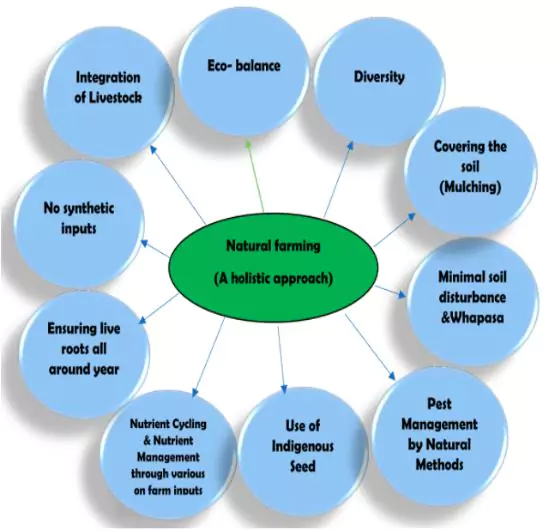The Union Cabinet approved the National Mission on Natural Farming (NMNF) in November 2024 as a standalone Centrally Sponsored Scheme under the Ministry of Agriculture & Farmers’ Welfare.
What is Natural Farming ?
- Definition: Chemical-free farming method integrating livestock (preferably local breed of cow) and diversified crops, rooted in Indian traditional knowledge.
Paramparagat Krishi Vikas Yojana (PKVY)
- Launch Year: 2015.
- Scheme Type: Extended component of Soil Health Management (SHM) under Centrally Sponsored Scheme (CSS), National Mission on Sustainable Agriculture (NMSA).
- Objective: Support and promote organic farming.
|
- Goals: Improve soil health, restore ecosystems, reduce input costs, and increase climate resilience.
- Ecosystem Approach: Recognizes interdependence of soil, water, microbiome, plants, animals, climate, and human needs.
- It was introduced by Masanobu Fukuoka in his book The One-Straw Revolution (1975)
- It is promoted in India as Bhartiya Prakritik Krishi Paddhati Programme (BPKP) under Paramparagat Krishi Vikas Yojana (PKVY)
Components of Natural Farming: These practices create a favorable microclimate that supports maximum beneficial microbial activity in the soil:
- Beejamrutham – Coating seeds with a microbial mixture made from cow dung and cow urine to enhance seed health.
- Jeevamrutham – Applying a blend of cow dung, cow urine, jaggery, pulse flour, water, and soil to boost the population of beneficial soil microbes.
- Mulching – Adding organic cover to the soil to enrich humus formation and reduce water evaporation.
- Waaphasa – Maintaining optimal soil aeration and moisture by creating a favorable microclimate.
- Insect and Pest Management – Using natural decoctions (kashyams) made from cow dung, cow urine, and green chilies to control pests safely.
About National Mission on Natural Farming (NMNF)
- Scheme Type: Centrally Sponsored Scheme under Ministry of Agriculture & Farmers’ Welfare.
- Financial Outlay (till 2025-26, end of 15th Finance Commission): ₹2,481 crore total.
- Aim: To strengthen sustainable agriculture, enhance soil health, restore ecosystems, reduce farmers’ input costs, and build climate resilience and safe food systems.
- Coverage: 7.5 lakh hectares across 15,000 natural farming clusters.
Objectives of NMNF
- Sustainable Farming: Promote nature-based systems using on-farm bio-inputs to reduce dependency on purchased inputs and lower input costs.
- Soil & Sustainability: Improve soil health and encourage sustainable agricultural practices.
- Livestock Integration: Popularize livestock-based models (preferably local cow breeds) integrating agriculture and animal husbandry.
 Research & Extension: Strengthen agro-ecological research and extension services through ICAR, KVKs, and Agricultural Universities.
Research & Extension: Strengthen agro-ecological research and extension services through ICAR, KVKs, and Agricultural Universities.- Knowledge Integration: Combine farmer experience with scientific expertise to develop location-specific NF practices.
- Standards & Certification: Establish scientifically supported standards and farmer-friendly certification for chemical-free produce.
- National Branding: Create and promote a single national brand for naturally grown chemical-free produce.
Components of NMNF
- Natural Farming Clusters: MNF targets 7.5 lakh hectares across 15,000 natural farming clusters, each covering 50 ha and 125 farmers.
- Bio-input Resource Centres (BRCs): 10,000 need-based centres to be set-up for easy availability of ready-to-use inputs for farmers.
- Community Support: Deployment of two Krishi Sakhis/Community Resource Persons (CRPs) per cluster to guide farmers and raise community awareness.
Krishi Vigyan Kendras (KVKs)
- Origin: Concept framed by Prof. M.S. Swaminathan, known as the Father of Agricultural Research in India.
- Role: Function as Knowledge & Resource Centres for agricultural technology.
- Linkages: Connect National Agricultural Research System (NARS) with extension systems and farmers.
|
Implementation
- Training Programs: Extensive training through KVKs, Agricultural Universities, local NF institutions, and model demonstration farms.
- Incentives: Output-based incentive of ₹4,000 per acre per year for up to 1 acre per farmer over two years.
- Certification: Simple farmer-friendly certification system m anaged by National Centre for Organic & Natural Farming (NCONF) under Participatory Guarantee System (PGS) – India.
- Monitoring: Real-time geo-tagged monitoring through the NMNF Portal.
Convergence & Policy Integration
- Coordination with Central and State Government schemes: Agriculture & Farmers Welfare, Rural Development, Food Processing, Panchayati Raj, AYUSH, Cooperation, and Animal Husbandry.
- Market Linkages: Engagement with National and International organisations for livestock enhancement, NF demonstration farms, and local market linkages via APMCs, Haats, and depots.
- Student Engagement: Students will be engaged in NMNF through the Rural Agricultural Work Experience (RAWE) program and dedicated Undergraduate, Postgraduate & Diploma courses on NF.
Need for Natural Farming
- Pressure on Limited Resources: Small and marginal farmers face high pressure on soil and water, leading to soil degradation and falling water tables; NF offers a path to sustainable farming.
- Post-Green Revolution Shift: Move from high-input farming to sustainable, climate-resilient systems that reduce environmental impact.
- Mass Movement Approach: Requires scientific backing, long-term investment, and strong extension networks involving farmers, SHGs, PACS, FPOs, and local NF institutions.
Challenges Related to Natural Farming
- Initial Decrease in Yield : Transition from conventional to natural farming often causes initial yield decline.
- Climate Dependence: Heavy dependence on climatic conditions reduces resilience to climate variability. IPCC warns that climate change poses risks to stability and predictability of natural farming systems.
- Input Preparation Difficulties: Making bio-inputs (e.g., Jeevamrit, Beejamrit) demands time, labor, and resources.
- Lessons from Sri Lanka: Sri Lanka’s rapid shift to 100% organic farming and ban on chemical fertilizers caused Sharp yield drops in key crops like rice, Threats to food security, Economic and political instability
Global Adoption of Natural Farming
International Initiatives
- At COP26 (Glasgow, November 2021), 45 governments, led by the UK, pledged action to protect nature and promote sustainable agriculture.
- The commitment aimed to leverage over $4 billion in public investment for improving soil health and making sustainable farming techniques accessible to farmers.
European Union Measures
- In May 2020, the EU launched the Farm to Fork Strategy under the European Green Deal.
- Goals include reducing chemical pesticide use and risks by 50% and limiting the use of the most hazardous pesticides by 2030.
Lessons from Sri Lanka
- Sri Lanka attempted to transition entirely to organic farming in April 2021, banning chemical fertilizers and imports of agrochemicals.
- The move caused reduced crop yields and contributed to high inflation (overall 8.3%, food inflation 11.7%).
|
![]() 14 Aug 2025
14 Aug 2025

 Research & Extension: Strengthen agro-ecological research and extension services through ICAR, KVKs, and Agricultural Universities.
Research & Extension: Strengthen agro-ecological research and extension services through ICAR, KVKs, and Agricultural Universities.